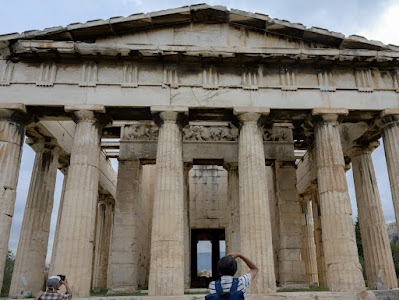More Inca ruins round Cusco
Tambo Machay has some hewn stone and a channel for a fresh water spring. It is thought that the Incas used it for water worship or some sort of ritual cleansing. At the entrance to the site there was the normal group of people selling handicrafts and a lady with two alpacas posing for photographs at the cost of 1 sol (25p)
It is not far down the hill to the site of Puca Pucara where there is a group of Inca buildings standing on a promontary, thought to be used as a hunting lodge or a watch tower.
 |
| The hills from Puca Pucara |
From Puca Pucara it is a fairly long hike to the next Inca site. We walked down past a pond and some fields where people were working. There were some donkeys on the side of the field and I stopped to photograph them. Immediately an elderly lady about 50m away shouted out 'Mi burro, mi burro' and put her hand out for a sol. I am always amazed that the locals wear traditional dress all the time and have not resorted to tracksuits.
The path continued through farm land skirted by woodland and hills. It became boggier as we progressed and we had to negotiate a stream several times. With the hills on either side and the boulders it reminded me a little of the Watkin path up to Snowdon.
We stopped on a large outcrop of rock with a flat top and an altar that looked like a chair, which Mairi obligingly sat in. We rested on the top and snacked on biscuits and water.
We carried on down to Salapunca passed more large boulders. Salapunca was an outcrop of rock with Inca steps carved in to the side of it and more altars.
 |
| Site at Qenko - surrounded by eucalyptus trees, not native but the commonest tree in the Andes |
 |
| Stone that casts puma shadow at the winter solstice |
 |
| A baby tarantula nestling amongst the stones |
Underneath the altar a tunnel led to another altar which Edwin said was thought to be a slab where the priests would prepare the body of a king or nobleman for mummification. He said that the site in Inca times would only be used by prists or royalty as it was a sacred site or huaca.
 |
| The 'mortuary'slab |
Edwin gave us a potted history of the Inca. They were thought to come originally from around Lake Titicaca and were led by Manco Capac towards Cusco. They at first set up residence in the hills above Cusco as there were already inhabitants, but by the 13th century they had occupied Cusco itself and were building the city up to be their capital. The Inca king Patchacutec (1438-1471)was responsible for the design of Cusco and also the expansion of the Incas into the southern Andes and Bolivia. His son Topa Inca carried the expansion up and into Ecuador.
When each inca emperor died his body would be mummified and brought back to his palace. There the household would continue with the mummy and his palace and possessions being attended to by a retinue of servants. The mummy would be brought out brought out in procession on feast days and to attend the crowning of a new emperor. The new emperor would have to build a whole new palace and could not live in a former residence. By the time the Spanish invaded there were 12 such palaces in Cusco. This practice fuelled the expansionist tendencies of the Inca kings as they could not use the inherited wealth of their forebears who still resided in their palaces.
 |
| Edwin with an explanation |
 |
| Looking back at Qenko |
From Qenko Edwin led us down the hill to the top of Cusco and the enormous site of Sacsayhuaman. He took us in the 'back way' through a tunnel in the rock to a grassy area that locals use for picnics. There was an extremely large grooved rock which had been worn smooth as he said it was used as a slide although it was originally an Incan sacred site.
 |
| Mairi finds a puppy on the way down to Sacsayhuaman |
 |
| Through the tunnel |
 |
| View in to the 'picnic' area with rock on far side |
 |
| Mairi and Naomi sliding |
We moved from here around the other side of the rock to a very large grass area known as the 'esplanade'. The rock here is called the 'Inca Throne'.
Running the length of the side opposite the rock (361m) were three tiers of enormous stone blocks forming a zigzag. This structure is thought to be earthquake proof.
 |
| Edwin Mairi and Naomi standing in front of the zigzags |























Comments
Post a Comment